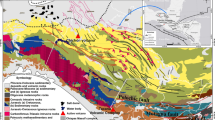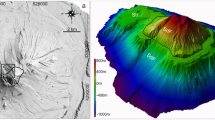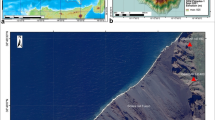Abstract
Edifices of stratocones and domes are often situated eccentrically above shallow silicic magma reservoirs. Evacuation of such reservoirs forms collapse calderas commonly surrounded by remnants of one or several volcanic cones that appear variously affected and destabilized. We studied morphologies of six calderas in Kamchatka, Russia, with diameters of 4 to 12 km. Edifices affected by caldera subsidence have residual heights of 250–800 m, and typical amphitheater-like depressions opening toward the calderas. The amphitheaters closely resemble horseshoe-shaped craters formed by large-scale flank failures of volcanoes with development of debris avalanches. Where caldera boundaries intersect such cones, the caldera margins have notable outward embayments. We therefore hypothesize that in the process of caldera formation, these eccentrically situated edifices were partly displaced and destabilized, causing large-scale landslides. The landslide masses are then transformed into debris avalanches and emplaced inside the developing caldera basins. To test this hypothesis, we carried out sand-box analogue experiments, in which caldera formation (modeled by evacuation of a rubber balloon) was simulated. The deformation of volcanic cones was studied by placing sand-cones in the vicinity of the expected “caldera” rim. At the initial stage of the modeled subsidence, the propagating ring fault of the caldera bifurcates within the affected cone into two faults, the outermost of which is notably curved outward off the caldera center. The two faults dissect the cone into three parts: (1) a stable outer part, (2) a highly unstable and subsiding intracaldera part, and (3) a subsiding graben structure between parts (1) and (2). Further progression of the caldera subsidence is likely to cause failure of parts (2) and (3) with failed material sliding into the caldera basin and with formation of an amphitheater-like depression oriented toward the developing caldera. The mass of material which is liable to slide into the caldera basin, and the shape of the resulted amphitheater are a function of the relative position of the caldera ring fault and the base of the cone. A cone situated mostly outside the ring fault is affected to a minor degree by caldera subsidence and collapses with formation of a narrow amphitheater deeply incised into the cone, having a small opening angle. Accordingly, the caldera exhibits a prominent outward embayment. By contrast, collapse of a cone initially situated mostly inside the caldera results in a broad amphitheater with a large opening angle, i.e. the embayment of the caldera rim is negligible. The relationships between the relative position of an edifice above the caldera fault and the opening angle of the formed amphitheater are similar for the modeled and the natural cases of caldera/cone interactions. Thus, our experiments support the hypothesis that volcanic edifices affected by caldera subsidence can experience large-scale failures with formation of indicative amphitheaters oriented toward the caldera basins. More generally, the scalloped appearance of boundaries of calderas in contact with pre-caldera topographic highs can be explained by the gravitational influence of topography on the process of caldera formation.










Similar content being viewed by others
References
Acocella V, Cifelli F, Funiciello R (2001) The control of overburden thickness of resurgent domes: insights from analogue models. J Volcanol Geotherm Res 111:137–153
Belousov A (1995) The Shiveluch volcanic eruption of 12 November 1964—explosive eruption provoked by failure of the edifice. J Volcanol Geotherm Res 66: 357–365
Belousov A, Belousova M (1996) Large scale landslides on active volcanoes in XXth century—examples from Kurile-Kamchatka region (Russia). In: Senneset K (ed) Landslides. Balkema, Rotterdam pp 953–957
Belousov A, Belousova M, Voight B (1999) Multiple edifice failures, debris avalanches and associated eruptions in the Holocene history of Shiveluch volcano, Kamchatka, Russia. Bull Volcanol 61:324–342
Braitseva OA, Melekestsev IV, Ponomareva VV, Sulerzhitsky LD (1995) Ages of calderas, large explosive craters and active volcanoes in the Kuril-Kamchatka region, Russia. Bull Volcanol 57:383–402
Branney MJ (1995) Downsag and extension at calderas: new perspectives on collapse geometries from ice-melt, mining and volcanic subsidence. Bull Volcanol 57:303–318
Druitt DH, Sparks RSJ (1984) On the formation of calderas during ignimbrite eruptions. Nature 310:679–681
Druitt TH, Edwards L, Mellors RM, Pyle DM, Sparks RSJ, Lanphere M, Davies M, Barriero B (1999) Santorini volcano. Geol Soc Lond Mem 19:1–165
Francis PW (1985) The origin of the Krakatau tsunamis. J Volcanol Geotherm Res 25:349–364
Francis PW (1993) Volcanoes: a planetary perspective. Clarendon Press, Oxford, pp 1–443
Glicken G (1998) Rockslide-debris avalanche of May 18, 1980, Mount St. Helens volcano, Washington. Bull Geol Soc Jpn 49:55–105
Hubbert M (1937) Theory of scale models as applied to the study of geologic structures. Geol Soc Am Bull 48:1459–1520
Ivanov BV (1970) Eruption of Karymsky volcano in 1962–1965 and volcanoes of Karymsky group (in Russian). Nauka, Moscow, pp 1–134
Ivanov BV, Braitseva OA, Zubin MI (1991) Karymsky volcano. In: Fedotov SA, Masurenkov YuP (eds) Active volcanoes of Kamchatka. vol. 2, Nauka, Moscow, pp 182–203
Kennedy B, Stix J, Vallance JW, Lavallée Y, Longpré M-A (2004) Controls on caldera structure: results from analogue sandbox modeling. Geol Soc Am Bull 116:515–524
Kienle J, Kowalik Z, Murty TS (1987) Tsunamis generated by eruptions from Mount St. Augustine volcano, Alaska. Science 236:1142–1147
Komuro H (1987) Experiments of cauldron formation: a polygonal cauldron and ring fractures. J Volcanol Geotherm Res 31:139–149
Latter JH (1981) Tsunamis of volcanic origin: summary of cases with particular reference to Krakatoa, 1883. Bull Volcanol 44:467–490
Lavallée Y, Stix J, Kennedy B, Richer M, Longpré M-A (2004) Caldera subsidence in areas of variable topographic relief: results from analogue modeling. J Volcanol Geotherm Res 129:219–236
Leonov VL, Grib EN, Karpov GA et al. (1991) Caldera Uzon and Valley of Geysers. In: Fedotov SA, Masurenkov YP (eds) Active volcanoes of Kamchatka. vol. 2, Nauka, Moscow, pp 94–137
Lipman PW (1976) Caldera-collapse breccias in the western San Juan Mountains, Colorado. Geol Soc Am Bull 87:1397–1410
Lipman PW (1997) Subsidence of ash flow calderas: relation to caldera size and chamber geometry. Bull Volcanol 59:198–218
Marti J, Ablay GJ, Redshaw LT, Sparks RSJ (1994) Experimental studies of collapse calderas. J Geol Soc Lond 151:919–929
Merle O, Vidal N, Van Wyk de Wries B (2001) Experiments on vertical basement fault reactivations below volcanoes. J Geophys Res 106:2153
Newhall C, Dzurisin D (1988) Historical unrest at large calderas of the world. US Geol Surv Bull 1855:1–1108
Newhall C, Punongbayan R (eds) (1996) Fire and mud: eruptions and lahars of Mount Pinatubo, Philippines. University of Washington Press, Seattle, pp 1–1126
Piip BI (1961) Kronotskie ignimbrites at Kamchatka. Tr Lab Vulc AN USSR 20
Pinel V, Jaupart C (2003) Magma chamber behavior beneath a volcanic edifice J Geophys Res 108(B2), 2072, DOI:10.1029/2002JB001751
Ramberg H (1981) Deformation structures in theory and experiments. Geol Soc Swed pp 1–131
Roche O, Druitt T, Merle O (2000) Experimental studies of caldera formation. J Geophys Res 105:395–416
Sanford A (1959) Analytical and experimental study of simple geological structures. Geol Soc Am Bull 42:19–52
Schultz RA (1996) Relative scale and the strength and deformability of rock masses. J Struct Geol 18:1139–1149
Seibert L (1984) Large volcanic debris avalanches: characteristics of source areas, deposits, and associated eruptions. J Volcanol Geotherm Res 22:163–197
Selyangin OB (1987) Petrogenesis of basalt-dacites in the connection with evolution of volcano-structures (in Russian). Nauka, Moscow, pp 1–148
Simkin T, Fiske RS (1983) Krakatau 1883: The volcanic eruption and its effects. Smithsonian Institution, Washington, DC, 494 pp
Troll VR, Emeleus CH, Donaldson CH (2000) Caldera formation in the Rum Igneous Complex, Scotland. Bull Volcanol 62:301–317
Troll VR, Walter TR, Schmincke H-U (2002) Cyclic caldera collapse: piston or piecemeal subsidence? Field and experimental evidence. Geology 30:135–138
Vidal N, Merle O (2000) Reactivation of basement faults beneath volcanoes: a new model of flank collapse. J Volcanol Geotherm Res 99:9–26
Voight B, Glicken G, Janda RL, Douglass PM (1981) Catastrophic rockslide avalanche of May 18. In: Lipman PW, Mullineaux DR (eds) The 1980 eruptions of Mount St. Helens, Washington. US Geol Surv Prof Pap 1250:347–378
Walker GPL (1984) Downsag calderas, ring faults, caldera sizes and incremental growth. J Geophys Res 89:8407–8416
Walter TR, Troll VR (2001) Formation of caldera periphery faults: an experimental study. Bull Volcanol 63:191–203
Williams H (1941) Calderas and their origin. Univ Calif Publ Bull Dep Geol Sci 25:239–346
Acknowledgements
A. Belousov thanks the Russian Foundation of Basic Research, which supported this study, and funding by the Alexander von Humboldt Foundation during his stay at the Dept. of Volcanology and Petrology at GEOMAR, Germany. T.R. Walter was supported by a grant of the Deutsche Forschungsgemeinschaft (WA1642–1/2) and V.R. Troll through a travel grant by Trinity College to visit GEOMAR. Special thanks to M. Belousova for final preparation of the manuscript. Reviews by J. Stix and J. Lavallée helped to improve the manuscript.
Author information
Authors and Affiliations
Corresponding author
Additional information
Editorial responsibility: J. Stix
Rights and permissions
About this article
Cite this article
Belousov, A., Walter, T.R. & Troll, V.R. Large-scale failures on domes and stratocones situated on caldera ring faults: sand-box modeling of natural examples from Kamchatka, Russia. Bull Volcanol 67, 457–468 (2005). https://doi.org/10.1007/s00445-004-0387-1
Received:
Accepted:
Published:
Issue Date:
DOI: https://doi.org/10.1007/s00445-004-0387-1




